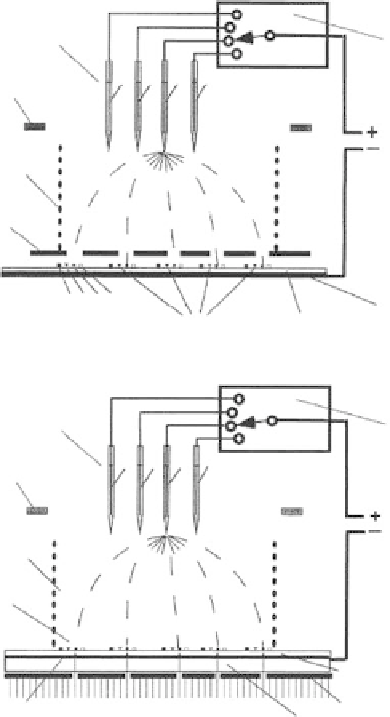Biomedical Engineering Reference
In-Depth Information
(a)
Capillaries
Switch
Guard
ring
ABCD
To power
supply
Dielectric
shield
Mask
A
BCD
Electrode
Substrate
Matrices
(b)
Capillaries
Switch
Guard
electrode
ABCD
To power
supply
Dielectric
shield
Matrices
Photoconductive
film
Photomask
support
Transparent
electrode
Light
Transparent
FIGURE 11.37
A schematic diagram of fabrication of biochip using electrospraying. (Reprinted from
Morozov, V.N. and Morozova, T.Y.,
Anal. Chem.
, 71, 3110, 1999. © American Chemical Society. With
permission.)
e l e c t r o s p r ay i in g , t h e d e p o s i t e d a in t i - I g G a in t i b o d y a r r ay s we r e b l o c k e d w i t h 2% s k i m m e d m i l k i in p h o s -
phate buffer solution (PBS) for 2 h at room temperature, then the plates were incubated with appropri-
ate quantities of horseradish peroxidase (HRP) or FITC-conjugated IgG antigens (100 ng/mL) for 1 h
at 37°C. The excess antigens were washed away with PBS/0.1% Tween 20 and PBS solution. Finally,
a protein multimicroarray with several kinds of IgG antibodies was manufactured. Figure 11.38
shows the electrospraying-deposited spots of anti-mouse IgG. The multimicroarray biochips fabri-
cated using electrospraying technique showed neither nonspecifi c absorption nor nonspecifi c binding.
These electrosprayed protein spots were still biologically active, which was advantageous to the repro-
ducible quantifi cation of antigens. The experiment demonstrated that this technique is applicable in
protein array biochip manufacturing, allowing the spontaneous deposition of many identical arrays.
Moerman et al. applied a miniaturized electrospraying technique to produce microarrays of
reproducible micrometer-sized biomaterial spots [93]. In the process, the charged jet from the capil-
lary tip broke into a spray of charged droplets and deposited in the form of uniform spots at 220-
400 µm on a substrate. The study demonstrated that electrospraying in a stable cone-jet mode at
<
400 µm spraying distance was a powerful technique to produce spots in a micrometer-sized range.
After a spot was prepared, the distance between the capillary tip and the substrate was increased


